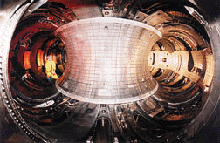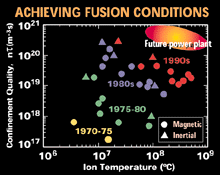Moving farther out into space, one finds that fascinating plasma phenomena
continue to proliferate: The pressure of interstellar plasmas and fields
contains the solar wind inside an irregularly shaped region called the heliosphere.
Extending for several hundred light years around the heliosphere is a mysterious
"bubble" of hot, x-ray-emitting plasma, a structure that may have
been caused by a nearby supernova explosion in the distant past. Deeper
into the Milky Way, understanding the intense radiation from spinning neutron
stars called x-ray pulsars involves plasma physics in one of its most extreme
settings. Thought to consist of a kind of infernal version of Earth's aurorae,
the displays probably come about as material ripped from a binary stellar
companion falls down the neutron star's field lines. The magnetic field
strength can be so large and the spiraling orbits of electrons so tight
that, like electrons in an atom, their motion becomes quantized, totally
altering the character of the plasma.

COPIOUS AMOUNTS OF FUSION POWER has been observed in the Tokamak
Fusion Test Reactor (TFTR). The toroidal region in which the plasma is contained
is shown in (a). On the outside, shown in (b), the toroidal structure is
surrounded by magnetic field coils, neutral beam injectors, and the vast
array of diagnostics necessary to study ultra-hot plasmas. [Courtesy of
Princeton Plasma Physics Laboratory]
![]()
The hordes of normal, glowing stars like the sun are a much more common sight in the sky than such extreme displays. In the stars' central cores, the plasma is so hot that light nuclei
within it can overcome their mutual repulsion and fuse into heavier nuclei, emitting energetic particles in the process and ultimately driving the stars' luminous output. Since the fuel for such reactions is plentiful on Earth, plasma physicists have labored for decades to stably confine hot thermonuclear plasmas in laboratory devices, with the goal of using them as large power plants to replace those based on nonrenewable fossil fuels. This power production method would produce no greenhouse gases and its radioactive by-products would have much shorter life times than those created in fission reactors. On the downside, because of a hot plasma's furious and infuriating ability to squirm through any cage that is put around it, no net-power-generating plasma has yet been demonstrated. Thus the feasibility of a practical fusion power plant is still to be proved.

PROGRESS IN FUSION confinement is approaching practical fusion
energy producing regimes. [Courtesy of Contempory Physics Education Project]
Still, many plasma physicists remain optimistic. They point out that the overall amounts of power produced by real fusion devices have increased by a factor of a trillion over the past two and a half decades. Researchers have scored a number of recent successes in donut-shaped devices called tokamaks, which use twisting magnetic field lines to confine hot plasmas. In laboratories in the United States and around the world, researchers believe they may have gained crucial insights into how to confine such plasmas without inducing the deleterious instabilities arising from spontaneously generated waves that usually spring leaks in the confinement. The potential payoff of such research is enormous.
Yet another concept for making fusion power plants ignores magnetic fields for confining the plasma and instead zaps a pellet of fuel from all directions with intense laser or ion beams. This compresses and heats the pellet, briefly creating the proper conditions for fusion to take place. While the potential of this method as a practical energy source will likely be the subject of